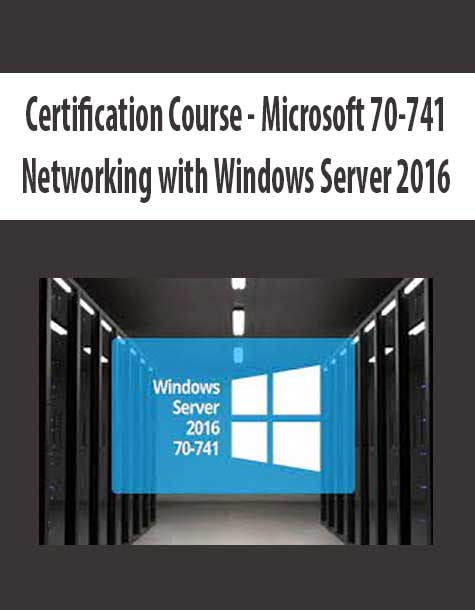[Download Now] Microsoft 70-741: Networking with Windows Server 2016
PLEASE REFER TO OUR PROOF : WATCH HERE!
Salepage: Microsoft 70-741: Networking with Windows Server 2016
This course, 70-741: Networking with Windows Server 2016, covers the essential networking skills required to design, deploy, configure and support Windows Server 2016 in most organizations. It elaborates on the TCP/IP fundamentals, remote access technologies, and more advanced content including Software Defined Networking.
The course 70-741: Networking with Windows Server 2016 is part of a three course series required to pass the MCSA: Windows Server 2016 certification. The course curriculum is designed keeping in view the exam topics covered in the Microsoft exam 70-741. In this way, this course is equally helpful for IT professionals looking to gain their knowledge as well as the candidates willing to appear in the said exam.
Career Path: The 70-741 exam is geared toward network administrators that are looking to reinforce their existing skills and learn about new networking technology changes and functionality in Windows Server 2016.
Course Curriculum
Course Introduction
StartCourse Introduction (3:23)
StartInstructor Introduction (1:24)
Chapter 01 – Plan and Implement IPv4 and IPv6 Networks
StartChapter 1 Introduction (2:39)
StartTopic A: Plan and Implement IP Addressing Schemes for IPv4 Networks (1:28)
StartGeneral Networking Requirements (4:55)
StartIPv4 Required Settings (3:27)
StartIPv4 Addresses (2:40)
StartIPv4 Subnet Masks (3:58)
StartDefault Gateways (2:19)
StartDemo – Understanding Binary Addressing (12:29)
StartIPv4 Address Classes (5:20)
StartWhat are Subnets? (1:54)
StartThe Subnetting Method (3:25)
StartSubnet Creation Process (3:29)
StartDemo – Subnetting a Network (21:34)
StartIPv4 Address Types (7:25)
StartIPv4 Network Types (2:15)
StartDemo – Examining VLSM (13:38)
StartTopic B: Configuring IPv4 Hosts (0:49)
StartIPv4 Configuration (2:30)
StartIPv4 Configuration Tools (2:42)
StartDemo – Configuring IPv4 (12:04)
StartTopic C: Managing and Troubleshooting IPv4 Connectivity (0:37)
StartNetwork Routing (3:50)
StartWorking with Routing Tables (1:33)
StartAdding Static Routes (2:28)
StartIPv4 Troubleshooting Methodology (3:16)
StartCommand Line Troubleshooting Tools (3:37)
StartGraphical Troubleshooting Tools (1:33)
StartTroubleshooting with Windows PowerShell (2:07)
StartDemo – Troubleshooting IPv4 (14:32)
StartMicrosoft Message Analyzer (1:23)
StartTopic D: Implementing IPv6 for Network Hosts (1:14)
StartThe Purpose of IPv6 (0:56)
StartReasons to Use IPv6 (2:29)
StartComparing IPv4 and IPv6 (2:21)
StartIPv6 Address Structure (3:22)
StartIPv6 Address Types (3:14)
StartIPv6 Autoconfiguration (3:49)
StartConfiguring IPv6 (1:18)
StartTools for Configuring IPv6 (1:25)
StartTopic E: Implementing IPv6 Transitioning and Coexistence (0:44)
StartUnderstanding Node Types (2:27)
StartOptions for Coexistence (1:47)
StartIPv6 over IPv4 Tunneling (2:15)
StartUnderstanding ISATAP (2:20)
StartUnderstanding 6to4 (1:43)
StartUnderstanding Teredo (2:11)
StartTransitioning Process (2:23)
StartChapter 01 Summary (1:56)
StartChapter 01 Review (0:10)
StartChapter 01 Quiz
Chapter 02 – Installing and Configuring DHCP
StartChapter 2 Introduction (1:07)
StartTopic A: Overview of the DHCP Server Role (0:20)
StartIntroducing DHCP (2:08)
StartDHCP Components and Processes (3:06)
StartLease Generation Process (3:37)
StartLease Renewal Process (3:11)
StartDHCP Considerations (3:32)
StartTopic B: Deploying DHCP (0:13)
StartInstall and Configure a DHCP Server (2:25)
StartDHCP Authorization (3:54)
StartDemo – Installing DHCP (7:23)
StartCreating Scopes (3:14)
StartConfiguring DHCP Options (2:12)
StartDemo – Creating and Configuring Scopes (13:06)
StartDHCP Relay Agents (3:20)
StartTopic C: Managing and Troubleshooting DHCP (0:23)
StartImplementing Security for DHCP (5:22)
StartDHCP Auditing (1:27)
StartDemo – Configuring Security and Auditing (8:44)
StartDHCP Advanced Options (2:58)
StartAdditional Scope Types (3:00)
StartHigh Availability for DHCP (4:10)
StartDHCP Failover (4:11)
StartDemo – Configuring DHCP Failover (5:21)
StartDHCP Database (4:27)
StartMigrating DHCP (1:23)
StartTroubleshooting DHCP (5:25)
StartChapter 02 Summary (1:32)
StartChapter 02 Review (0:10)
StartChapter 02 Quiz
Chapter 03 – Installing and Configuring DNS
StartChapter 03 Introduction (1:53)
StartTopic A: Implementing DNS Servers (0:43)
StartName Resolution Basics (1:55)
StartWhat is DNS? (5:09)
StartDNS Namespace (1:40)
StartTypes of Names (1:24)
StartInternet Name Resolution (3:25)
StartDNS Components (3:34)
StartDNS Zones and Resource Records (1:56)
StartInstalling the DNS Server (2:04)
StartDemo – Installing DNS (5:43)
StartTopic B: Creating and Configuring DNS Zones (0:32)
StartResource Records (4:02)
StartZone Types (4:40)
StartReplicating Zones (2:49)
StartDemo – Creating and Configuring DNS Zones (16:57)
StartStandard DNS Name Resolution (1:33)
StartModifying DNS Name Resolution (2:15)
StartWorking with DNS Cache (2:53)
StartDemo – Configuring Cache and Forwarding (6:16)
StartUnderstanding Domain Delegation (2:42)
StartDemo – Domain Delegation (7:11)
StartTopic C: Understanding Active Directory Integration (0:21)
StartOverview of AD DS and DNS Integration (2:16)
StartSRV Records (2:36)
StartDemo – Examining SRV Records (6:01)
StartActive Directory Integrated Zones (4:07)
StartApplication Partitions (3:30)
StartDemo – Configuring Active Directory Integrated Zones (4:46)
StartTopic D: Configuring Advanced DNS Settings (0:24)
StartAdvanced Name Resolution (5:09)
StartThe GlobalNames Zone (2:26)
StartDemo – Configuring the GlobalNames Zone (5:43)
StartSplit DNS (4:12)
StartIntroducing DNS Policies (2:04)
StartDNS Policy Objects (2:20)
StartDemo – Configuring DNS Policies (10:38)
StartImplementing DNS Security (3:30)
StartDNS Security (DNSSEC) (1:48)
StartImplementing DNSSEC (2:37)
StartTopic E: Troubleshooting DNS Name Resolution (0:24)
StartIntroduction to DNS Troubleshooting (1:29)
StartObtaining DNS Server Statistics (0:50)
StartCommand Line Tools (1:00)
StartTroubleshooting Process (1:47)
StartManaging DNS Services (0:48)
StartTesting DNS Servers (1:12)
StartDemo – Managing and Troubleshooting DNS (19:12)
StartChapter 03 Summary (1:38)
StartChapter 03 Review (0:10)
StartChapter 03 Quiz
Chapter 04 – Implementing and Managing IP Address Management
StartChapter 04 Introduction (1:03)
StartTopic A: Overview of IPAM (0:34)
StartIntroducing IPAM (3:04)
StartIPAM Benefits (1:04)
StartNew Features in Windows Server 2016 (2:13)
StartIPAM Architecture (2:46)
StartIPAM Deployment Requirements (2:06)
StartIPAM Deployment Considerations (3:03)
StartTopic B: IPAM Deployment (0:13)
StartImplementing IPAM (2:23)
StartDemo – Installing and Provisioning the IPAM Role (23:02)
StartIPAM Administration (2:30)
StartDefault IPAM Groups (1:57)
StartDemo – Administering IPAM (6:44)
StartConfiguring IPAM Options (2:12)
StartDemo – Managing DNS and DHCP Servers using IPAM (9:44)
StartTopic C: Managing IP Address Spaces by using IPAM (1:11)
StartManaging IP Addressing (1:07)
StartViewing and Managing IP Addressing (2:31)
StartMonitoring DHCP and DNS Servers (1:32)
StartAdding Address Spaces (1:01)
StartFinding, Allocating, and Reclaiming (1:48)
StartDemo – Managing IP Addressing with IPAM (6:27)
StartChapter 04 Summary (1:37)
StartChapter 04 Review (0:10)
StartChapter 04 Quiz
Chapter 05 – Implementing Remote Access
StartChapter 05 Introduction (1:23)
StartTopic A: Remote Access Overview (0:15)
StartWhat is Remote Access? (3:07)
StartRemote Access Options (1:51)
StartManaging Remote Access (1:10)
StartDemo – Installing the Remote Access Role (3:38)
StartThe Remote Access Management Console (1:47)
StartNetwork Policy Server (2:33)
StartNPS Policies (4:16)
StartUsing a PKI for Remote Access (4:33)
StartRouting with Windows Server 2016 (1:33)
StartNetwork Address Translation (2:45)
StartTopic B: Implementing the Web Application Proxy (0:14)
StartOverview of Web Application Proxy (3:23)
StartAuthentication Options (3:04)
StartConfiguring the Web Application Proxy (1:45)
StartTopic C: Planning and Implementing VPNs (0:16)
StartRemote Access with VPNs (3:28)
StartVPN Connection Properties (1:38)
StartTunneling Protocols (5:31)
StartAuthentication Protocols (4:47)
StartVPN Reconnect (1:31)
StartApp – triggered VPNs (2:22)
StartConfiguring a VPN Server (1:53)
StartVPN Configuration Options (2:50)
StartDemo – Configuring a VPN Server (6:59)
StartTopic D: Overview of DirectAccess (0:38)
StartIntroducing DirectAccess (2:02)
StartDirectAccess Components (5:20)
StartDeployment Options (1:53)
StartDirectAccess Server Prerequisites (1:25)
StartTunneling Protocol Options (2:04)
StartDirectAccess Process Internally (1:51)
StartDirectAccess Process Externally (6:12)
StartTopic E: Implementing DirectAccess (0:15)
StartSimple DirectAccess Configuration (0:37)
StartConfiguration Changes (3:48)
StartLimitations of Simple Configuration (2:40)
StartAdvanced DirectAccess Options (2:12)
StartHigh Availability (3:26)
StartMultisite Deployments (1:35)
StartConfiguring a PKI for DirectAccess (2:48)
StartImplementing Client Certificates (1:37)
StartInternal Network Configuration Options (3:53)
StartConfiguring DNS Settings (2:11)
StartMonitoring DA Connectivity (1:41)
StartChapter 05 Summary (2:09)
StartChapter 05 Review (0:10)
StartChapter 05 Quiz
Chapter 06 – Installing and Configuring Branch Office Networking
StartChapter 06 Introduction (1:05)
StartTopic A: Configuring Networking for Branch Offices (0:23)
StartBranch Office Scenarios (4:09)
StartConsiderations for Branch Offices (3:17)
StartWAN Connectivity (3:17)
StartNetwork Services for Branch Offices (3:07)
StartImplementing RODCs (5:37)
StartDemo – Installing an RODC (8:12)
StartPresentation Virtualization (2:01)
StartRemote Desktop Services (2:12)
StartFile Services for Branch Offices (2:44)
StartPrint Services for Branch Offices (4:01)
StartTopic B: Implementing Distributed File Systems (0:36)
StartIntroducing DFS (2:01)
StartDFS Components (1:11)
StartTypes of DFS Namespaces (3:12)
StartDeploying DFS Namespaces (4:49)
StartCreating and Managing a DFS Namespace (1:23)
StartDemo – Creating a DFS Namespace (8:50)
StartDFS Replication (5:03)
StartDFS Scenarios (3:26)
StartDemo – Configuring Replication (5:38)
StartOptimizing DFS (5:16)
StartManaging the DFS Database (1:25)
StartMonitoring and Troubleshooting DFS (1:40)
StartTopic C: Implementing BranchCache (0:15)
StartIntroducing BranchCache (1:44)
StartBranchCache in Windows Server 2016 (1:06)
StartBranchCache Modes (2:15)
StartData Retrieval using BranchCache (2:29)
StartBranchCache Requirements (3:09)
StartDemo – Configuring and Enabling BranchCache (8:31)
StartChapter 06 Summary (1:59)
StartChapter 06 Review (0:10)
StartChapter 06 Quiz
Chapter 07 – Implementing Advanced Networking Features
StartChapter 07 Introduction (1:38)
StartTopic A: Implementing Networking Features for High Performance (0:10)
StartHigh Performance Networking Features (0:45)
StartNIC Teaming (3:45)
StartDemo – Implementing NIC Teaming (5:54)
StartSMB 3.1.1 Shared Folders (2:00)
StartAdvanced SMB 3.1.1 Functionality (5:59)
StartQuality of Service (QoS) (2:12)
StartUnderstanding RSS (1:16)
StartUnderstanding RSC (1:36)
StartTopic B: Implementing Hyper-V Advanced Networking Features (0:24)
StartVirtual Switch Improvements (4:36)
StartExtensible Virtual Switch (2:19)
StartUnderstanding SR-IOV (1:26)
StartDynamic VMQ (1:50)
StartAdvanced Features for Network Adapters (2:00)
StartNIC Teaming in Virtual Machines (0:42)
StartTopic C: Introduction to Software-Defined Networking (0:22)
StartSDN Concepts and Tools (3:21)
StartSDN Benefits (1:52)
StartPlanning for Software-Defined Networking (1:15)
StartSDN Deployments (2:57)
StartTopic D: Overview of Network Virtualization (0:18)
StartIntroduction to Network Virtualization (1:30)
StartNetwork Virtualization Benefits (2:44)
StartGeneric Route Encapsulation (2:02)
StartChapter 07 Summary (1:40)
StartChapter 07 Review (0:10)
StartChapter 07 Quiz
StartCourse Closure (2:13)
Delivery Method
– After your purchase, you’ll see a View your orders link which goes to the Downloads page. Here, you can download all the files associated with your order.
– Downloads are available once your payment is confirmed, we’ll also send you a download notification email separate from any transaction notification emails you receive from coursesblock.com.
– Since it is a digital copy, our suggestion is to download and save it to your hard drive. In case the link is broken for any reason, please contact us and we will resend the new download link.
– If you cannot find the download link, please don’t worry about that. We will update and notify you as soon as possible at 8:00 AM – 8:00 PM (UTC 8).
Thank You For Shopping With Us!







